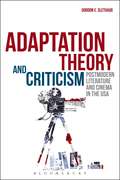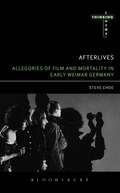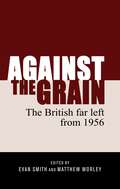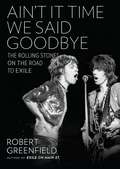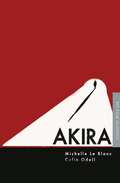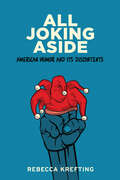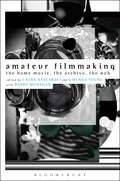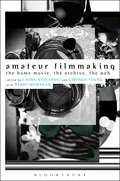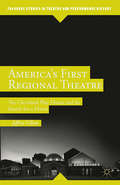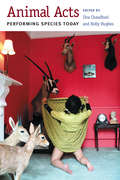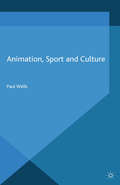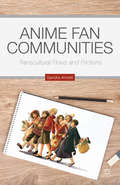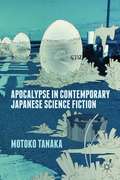- Table View
- List View
Adaptation Theory and Criticism: Postmodern Literature and Cinema in the USA
by Gordon E. SlethaugTraditional critics of film adaptation generally assumed a) that the written text is better than the film adaptation because the plot is more intricate and the language richer when pictorial images do not intrude; b) that films are better when particularly faithful to the original; c) that authors do not make good script writers and should not sully their imagination by writing film scripts; d) and often that American films lack the complexity of authored texts because they are sourced out of Hollywood. The 'faithfulness' view has by and large disappeared, and intertextuality is now a generally received notion, but the field still lacks studies with a postmodern methodology and lens.Exploring Hollywood feature films as well as small studio productions, Adaptation Theory and Criticism explores the intertextuality of a dozen films through a series of case studies introduced through discussions of postmodern methodology and practice. Providing the reader with informative background on theories of film adaptation as well as carefully articulated postmodern methodology and issues, Gordon Slethaug includes several case studies of major Hollywood productions and small studio films, some of which have been discussed before (Age of Innocence, Gangs of New York, and Do the Right Thing) and some that have received lesser consideration (Six Degrees of Separation, Smoke, Smoke Signals, Broken Flowers, and various Snow White narratives including Enchanted, Mirror Mirror, and Snow White and the Huntsman). Useful for both film and literary studies students, Adaptation Theory and Criticism cogently combines the existing scholarship and uses previous theories to engage readers to think about the current state of American literature and film.
Adaptation Theory and Criticism: Postmodern Literature and Cinema in the USA
by Gordon E. SlethaugTraditional critics of film adaptation generally assumed a) that the written text is better than the film adaptation because the plot is more intricate and the language richer when pictorial images do not intrude; b) that films are better when particularly faithful to the original; c) that authors do not make good script writers and should not sully their imagination by writing film scripts; d) and often that American films lack the complexity of authored texts because they are sourced out of Hollywood. The 'faithfulness' view has by and large disappeared, and intertextuality is now a generally received notion, but the field still lacks studies with a postmodern methodology and lens.Exploring Hollywood feature films as well as small studio productions, Adaptation Theory and Criticism explores the intertextuality of a dozen films through a series of case studies introduced through discussions of postmodern methodology and practice. Providing the reader with informative background on theories of film adaptation as well as carefully articulated postmodern methodology and issues, Gordon Slethaug includes several case studies of major Hollywood productions and small studio films, some of which have been discussed before (Age of Innocence, Gangs of New York, and Do the Right Thing) and some that have received lesser consideration (Six Degrees of Separation, Smoke, Smoke Signals, Broken Flowers, and various Snow White narratives including Enchanted, Mirror Mirror, and Snow White and the Huntsman). Useful for both film and literary studies students, Adaptation Theory and Criticism cogently combines the existing scholarship and uses previous theories to engage readers to think about the current state of American literature and film.
Adorno and Performance (Performance Philosophy)
by Will Daddario Karoline GritznerAdorno and Performance offers the first comprehensive examination of the vital role of performance within the philosophy of Theodor W. Adorno. Capacious in its ramifications for contemporary life, the term 'performance' here unlocks Adorno's dialectical thought process, which aimed at overcoming the stultifying uniformity of instrumental reason.
Afterlives: Allegories Of Film And Mortality In Early Weimar Germany (Thinking Cinema)
by Steve ChoeWeimar cultural critics and intellectuals have repeatedly linked the dynamic movement of the cinema to discourses of life and animation. Correspondingly, recent film historians and theorists have taken up these discourses to theorize the moving image, both in analog and digital. But, many important issues are overlooked. Combining close readings of individual films with detailed interpretations of philosophical texts, all produced in Weimar Germany immediately following the Great War, Afterlives: Allegories of Film and Mortality in Early Weimar Germany shows how these films teach viewers about living and dying within a modern, mass mediated context. Choe places relatively underanalyzed films such as F. W. Murnau's The Haunted Castle and Arthur Robison's Warning Shadows alongside Martin Heidegger's early seminars on phenomenology, Sigmund Freud's Reflections upon War and Death and Max Scheler's critique of ressentiment. It is the experience of war trauma that underpins these correspondences, and Choe foregrounds life and death in the films by highlighting how they allegorize this opposition through the thematics of animation and stasis.
Afterlives: Allegories Of Film And Mortality In Early Weimar Germany (Thinking Cinema)
by Steve ChoeWeimar cultural critics and intellectuals have repeatedly linked the dynamic movement of the cinema to discourses of life and animation. Correspondingly, recent film historians and theorists have taken up these discourses to theorize the moving image, both in analog and digital. But, many important issues are overlooked. Combining close readings of individual films with detailed interpretations of philosophical texts, all produced in Weimar Germany immediately following the Great War, Afterlives: Allegories of Film and Mortality in Early Weimar Germany shows how these films teach viewers about living and dying within a modern, mass mediated context. Choe places relatively underanalyzed films such as F. W. Murnau's The Haunted Castle and Arthur Robison's Warning Shadows alongside Martin Heidegger's early seminars on phenomenology, Sigmund Freud's Reflections upon War and Death and Max Scheler's critique of ressentiment. It is the experience of war trauma that underpins these correspondences, and Choe foregrounds life and death in the films by highlighting how they allegorize this opposition through the thematics of animation and stasis.
Against the grain: The British far left from 1956 (PDF)
by Evan Smith Matthew WorleyAgainst the grain is the first general history of the British far left to be published in the twenty-first century. Its contents cover a range of organisations beyond the Labour Party, bringing together leading experts on British left-wing politics to examine issues of class, race and gender from 1956 to the present day. The essays collected here are designed to highlight the impact made by the far left on British politics and society. Though the predicted revolution did not come, organisations such as the International Socialists, the International Marxist Group and Militant became household names in the 1970s and 1980s. Taken as a whole, the collection demonstrates the extent to which the far left has weaved its influence into the political fabric of Britain.
Against the grain: The British far left from 1956
by Evan Smith Matthew WorleyAgainst the grain is the first general history of the British far left to be published in the twenty-first century. Its contents cover a range of organisations beyond the Labour Party, bringing together leading experts on British left-wing politics to examine issues of class, race and gender from 1956 to the present day. The essays collected here are designed to highlight the impact made by the far left on British politics and society. Though the predicted revolution did not come, organisations such as the International Socialists, the International Marxist Group and Militant became household names in the 1970s and 1980s. Taken as a whole, the collection demonstrates the extent to which the far left has weaved its influence into the political fabric of Britain.
Ain't It Time We Said Goodbye: The Rolling Stones on the Road to Exile
by Robert GreenfieldFor ten days in March 1971, the Rolling Stones traveled by train and bus to play two shows a night in many of the small theaters and town halls where their careers began. No backstage passes. No security. No sound checks or rehearsals. And only one journalist allowed. That journalist now delivers a full-length account of this landmark event, which marked the end of the first chapter of the Stones' extraordinary career.Ain't It Time We Said Goodbye is also the story of two artists on the precipice of mega stardom, power, and destruction. For Mick and Keith, and all those who traveled with them, the farewell tour of England was the end of the innocence.Based on Robert Greenfield's first-hand account and new interviews with many of the key players, this is a vibrant, thrilling look at the way it once was for the Rolling Stones and their fans-and the way it would never be again.
Ain't It Time We Said Goodbye: The Rolling Stones on the Road to Exile
by Robert GreenfieldFor ten days in March 1971, the Rolling Stones traveled by train and bus to play two shows a night in many of the small theaters and town halls where their careers began. No backstage passes. No security. No sound checks or rehearsals. And only one journalist allowed. That journalist now delivers a full-length account of this landmark event, which marked the end of the first chapter of the Stones' extraordinary career.Ain't It Time We Said Goodbye is also the story of two artists on the precipice of mega stardom, power, and destruction. For Mick and Keith, and all those who traveled with them, the farewell tour of England was the end of the innocence.Based on Robert Greenfield's first-hand account and new interviews with many of the key players, this is a vibrant, thrilling look at the way it once was for the Rolling Stones and their fans-and the way it would never be again.
Akira (BFI Film Classics)
by Michelle Le Blanc Colin OdellSuccessful in both Japan and the West, Akira had a huge impact on the international growth in popularity of manga and anime. Closely analysing the film and its key themes, Colin O'Dell and Michelle Le Blanc assess its historical importance, its impact on the Western perception of anime, and its influence on science fiction cinema.
Alien (BFI Film Classics)
by Roger LuckhurstA legendary fusion of science fiction and horror, Ridley Scott's Alien (1979) is one of the most enduring films of modern cinema – its famously visceral scenes acting like a traumatic wound we seem compelled to revisit.Tracing the constellation of talents that came together to produce the film, Roger Luckhurst examines its origins as a monster movie script called Star Beast, dismissed by many in Hollywood as B-movie trash, through to its afterlife in numerous sequels, prequels and elaborations.Exploring the ways in which Alien compels us to think about otherness, Luckhurst demonstrates how and why this interstellar slasher movie, this old dark house in space, came to coil itself around our darkest imaginings about the fragility of humanity.This special edition features original cover artwork by Marta Lech.
All Joking Aside: American Humor and Its Discontents
by Rebecca KreftingIn this examination of stand-up comedy, Rebecca Krefting establishes a new genre of comedic production, "charged humor," and charts its pathways from production to consumption. Some jokes are tears in the fabric of our beliefs—they challenge myths about how fair and democratic our society is and the behaviors and practices we enact to maintain those fictions. Jokes loaded with vitriol and delivered with verve, charged humor compels audiences to action, artfully summoning political critique. Since the institutionalization of stand-up comedy as a distinct cultural form, stand-up comics have leveraged charged humor to reveal social, political, and economic stratifications. All Joking Aside offers a history of charged comedy from the mid-twentieth century to the early aughts, highlighting dozens of talented comics from Dick Gregory and Robin Tyler to Micia Mosely and Hari Kondabolu. The popularity of charged humor has waxed and waned over the past sixty years. Indeed, the history of charged humor is a tale of intrigue and subversion featuring dive bars, public remonstrations, fickle audiences, movie stars turned politicians, commercial airlines, emergent technologies, neoliberal mind-sets, and a cavalcade of comic misfits with an ax to grind. Along the way, Krefting explores the fault lines in the modern economy of humor, why men are perceived to be funnier than women, the perplexing popularity of modern-day minstrelsy, and the way identities are packaged and sold in the marketplace.Appealing to anyone interested in the politics of humor and generating implications for the study of any form of popular entertainment, this history reflects on why we make the choices we do and the collective power of our consumptive practices. Readers will be delighted by the broad array of comic talent spotlighted in this book, and for those interested in comedy with substance, it will offer an alternative punchline.
Amateur Filmmaking: The Home Movie, the Archive, the Web
by Laura Rascaroli Gwenda Young Barry MonahanWith the advent of digital filmmaking and critical recognition of the relevance of self expression, first-person narratives, and personal practices of memorialization, interest in the amateur moving image has never been stronger. Bringing together key scholars in the field, and revealing the rich variety of amateur filmmaking-from home movies of Imperial India and film diaries of life in contemporary China, to the work of leading auteurs such as Joseph Morder and Péter Forgács-Amateur Filmmaking highlights the importance of amateur cinema as a core object of critical interest across an array of disciplines. With contributions on the role of the archive, on YouTube, and on the impact of new technologies on amateur filmmaking, these essays offer the first comprehensive examination of this growing field.
Amateur Filmmaking: The Home Movie, the Archive, the Web
by Laura Rascaroli Gwenda Young Barry MonahanWith the advent of digital filmmaking and critical recognition of the relevance of self expression, first-person narratives, and personal practices of memorialization, interest in the amateur moving image has never been stronger. Bringing together key scholars in the field, and revealing the rich variety of amateur filmmaking-from home movies of Imperial India and film diaries of life in contemporary China, to the work of leading auteurs such as Joseph Morder and Péter Forgács-Amateur Filmmaking highlights the importance of amateur cinema as a core object of critical interest across an array of disciplines. With contributions on the role of the archive, on YouTube, and on the impact of new technologies on amateur filmmaking, these essays offer the first comprehensive examination of this growing field.
American Playwriting and the Anti-Political Prejudice: Twentieth- and Twenty-First-Century Perspectives (Palgrave Studies in Theatre and Performance History)
by N. PressleyTwenty years after Tony Kushner's influential Angels in America seemed to declare a revitalized potency for the popular political play, there is a "No Politics" prejudice undermining US production and writing. This book explores the largely unrecognized cultural patterns that discourage political playwriting on the contemporary American stage.
American Theology, Superhero Comics, and Cinema: The Marvel of Stan Lee and the Revolution of a Genre (Routledge Studies in Religion and Film)
by Anthony MillsStan Lee, who was the head writer of Marvel Comics in the early 1960s, co-created such popular heroes as Spider-Man, Hulk, the X-Men, the Fantastic Four, Iron Man, Thor, and Daredevil. This book traces the ways in which American theologians and comic books of the era were not only both saying things about what it means to be human, but, starting with Lee they were largely saying the same things. Author Anthony R. Mills argues that the shift away from individualistic ideas of human personhood and toward relational conceptions occurring within both American theology and American superhero comics and films does not occur simply on the ontological level, but is also inherent to epistemology and ethics, reflecting the comprehensive nature of human life in terms of being, knowing, and acting. This book explores the idea of the "American monomyth" that pervades American hero stories and examines its philosophical and theological origins and specific manifestations in early American superhero comics. Surveying the anthropologies of six American theologians who argue against many of the monomyth’s assumptions, principally the staunch individualism taken to be the model of humanity, and who offer relationality as a more realistic and ethical alternative, this book offers a detailed argument for the intimate historical relationship between the now disparate fields of comic book/superhero film creation, on the one hand, and Christian theology, on the other, in the United States. An understanding of the early connections between theology and American conceptions of heroism helps to further make sense of their contemporary parallels, wherein superhero stories and theology are not strictly separate phenomena but have shared origins and concerns.
American Theology, Superhero Comics, and Cinema: The Marvel of Stan Lee and the Revolution of a Genre (Routledge Studies in Religion and Film)
by Anthony MillsStan Lee, who was the head writer of Marvel Comics in the early 1960s, co-created such popular heroes as Spider-Man, Hulk, the X-Men, the Fantastic Four, Iron Man, Thor, and Daredevil. This book traces the ways in which American theologians and comic books of the era were not only both saying things about what it means to be human, but, starting with Lee they were largely saying the same things. Author Anthony R. Mills argues that the shift away from individualistic ideas of human personhood and toward relational conceptions occurring within both American theology and American superhero comics and films does not occur simply on the ontological level, but is also inherent to epistemology and ethics, reflecting the comprehensive nature of human life in terms of being, knowing, and acting. This book explores the idea of the "American monomyth" that pervades American hero stories and examines its philosophical and theological origins and specific manifestations in early American superhero comics. Surveying the anthropologies of six American theologians who argue against many of the monomyth’s assumptions, principally the staunch individualism taken to be the model of humanity, and who offer relationality as a more realistic and ethical alternative, this book offers a detailed argument for the intimate historical relationship between the now disparate fields of comic book/superhero film creation, on the one hand, and Christian theology, on the other, in the United States. An understanding of the early connections between theology and American conceptions of heroism helps to further make sense of their contemporary parallels, wherein superhero stories and theology are not strictly separate phenomena but have shared origins and concerns.
America’s First Regional Theatre: The Cleveland Play House and Its Search for a Home (Palgrave Studies in Theatre and Performance History)
by J. UllomThe Cleveland Play House has mirrored the achievements and struggles of both the city of Cleveland and the American theatre over the past one hundred years. This book challenges the established history (often put forward by the theatre itself) and long-held assumptions concerning the creation of the institution and its legacy.
Anatomy of Performance Training
by John MatthewsWe train because we are human and we become human because we train. This is the surprising and original conclusion of Anatomy of Performance Training, in which John Matthews shows how training is a very human response to the problems of having a body and living in the world. Using illustrative case-studies of professional practice, each chapter addresses a specific body part, offering a self-contained discussion of its symbolic and practical significance in the artistic, and commercial, activities of training. These anatomical case-studies are cross-referenced with other disciplines (such as sport, high diving, deep diving and artisan craft) to further expand our understanding of performance. Stand-alone chapters, ideal for reference, build towards an overall conclusion that the uniquely human practice of training is emerging as a new and pervasive ideology globally.Ideal for readers seeking to understand the relationship the body has with the theatre and training, or for teachers looking for a new, innovative approach to performance, Anatomy of Performance Training is an accessible, original contribution to the philosophy of training for performance.
Anatomy of Performance Training: Embodiment Philosophy And Practice
by John MatthewsWe train because we are human and we become human because we train. This is the surprising and original conclusion of Anatomy of Performance Training, in which John Matthews shows how training is a very human response to the problems of having a body and living in the world. Using illustrative case-studies of professional practice, each chapter addresses a specific body part, offering a self-contained discussion of its symbolic and practical significance in the artistic, and commercial, activities of training. These anatomical case-studies are cross-referenced with other disciplines (such as sport, high diving, deep diving and artisan craft) to further expand our understanding of performance. Stand-alone chapters, ideal for reference, build towards an overall conclusion that the uniquely human practice of training is emerging as a new and pervasive ideology globally.Ideal for readers seeking to understand the relationship the body has with the theatre and training, or for teachers looking for a new, innovative approach to performance, Anatomy of Performance Training is an accessible, original contribution to the philosophy of training for performance.
Animal Acts: Performing Species Today (Critical Performances)
by Una Chaudhuri Holly HughesWe all have an animal story—the pet we loved, the wild animal that captured our childhood imagination, the deer the neighbor hit while driving. While scientific breakthroughs in animal cognition, the effects of global climate change and dwindling animal habitats, and the exploding interdisciplinary field of animal studies have complicated things, such stories remain a part of how we tell the story of being human. Animal Acts collects eleven exciting, provocative, and moving stories by solo performers, accompanied by commentary that places the works in a broader context. Work by leading theater artists Holly Hughes, Rachel Rosenthal, Deke Weaver, Carmelita Tropicana, and others joins commentary by major scholars including Donna Haraway, Jane Desmond, Jill Dolan, and Nigel Rothfels. Una Chaudhuri’s introduction provides a vital foundation for understanding and appreciating the intersection of animal studies and performance. The anthology foregrounds questions of race, gender, sexuality, class, nation, and other issues central to the human project within the discourse of the “post human,” and will appeal to readers interested in solo performance, animal studies, gender studies, performance studies, and environmental studies.
Animation, Sport and Culture
by P. WellsAnimation, Sport and Culture is a wide-ranging study of both sport and animated films. From Goofy to Goalkeepers, Wallace and Gromit to Tiger Woods, Mickey Mouse to Messi, and Nike to Nationhood, this Olympic-sized analysis looks at the history, politics, aesthetics and technologies of sport and animation from around the globe.
Anime Fan Communities: Transcultural Flows and Frictions
by S. AnnettHow have animation fans in Japan, South Korea, the United States, and Canada formed communities and dealt with conflicts across cultural and geographic distance? This book traces animation fandom from its roots in early cinema audiences, through mid-century children's cartoon fan clubs, to today's digitally-networked transcultural fan cultures.
Anna Halprin: Dance - Process - Form
by Gabriele Wittmann Ronit Land Ursula SchornThis book considers the creative work and therapeutic and pedagogical approach of Anna Halprin, a dancer, choreographer, and early pioneer in the expressive arts healing movement. It looks at her 'Life/Art Process®' and the wider impact of her work across the fields of art, education, therapy and politics.
Apocalypse in Contemporary Japanese Science Fiction
by M. TanakaStarting with the history of apocalyptic tradition in the West and focusing on modern Japanese apocalyptic science fiction in manga, anime, and novels, Motoko Tanaka shows how science fiction reflected and coped with the devastation in Japanese national identity after 1945.
